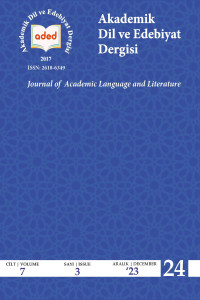Abstract
In this study, Tahir Harîmî Balcıoğlu's (1893-1951) story titled "Mayasıllı Muhtar Kabak Ali", published in 1936 and containing intense autobiographical observations about the center-periphery relationship, was analyzed. In this study, the Turkish intellectual's view of the periphery in the 1930s is discussed, based on the story mentioned. The aim of the study is to determine the autobiographical elements in the story within the framework of this issue and to show an example of a Turkish intellectual's relationship with the periphery by making use of archival documents. Both archive documents and biographical information about the author were examined in the context of the center-periphery conflict. In this review, within the framework of qualitative research methods, historical social research and document analysis methods were used eclectically together. The findings reveal that the author looks at this conflict from a very different perspective compared to other literary works that deal with the center-periphery conflict in Turkish literature. As in the literary works of the post-Republic period, in this work it is seen that the periphery has meanings beyond a mere place. In this respect, it can be said that there is a deep conflict between the center, which represents new knowledge, social change and modernity, and the periphery, which represents established order, traditional knowledge and opposition to change.
References
- Alus, S. M. (1944, 5 Ağustos). Eski İstanbul’da: Orosdi-Back, Ömer Efendi mağazası. Son Posta. 5-6.
Abstract
Bu çalışmada Tahir Harîmî Balcıoğlu’nun (1893-1951) 1936 yılında yayımlanan ve içerisinde merkez-taşra ilişkisine dair yoğun otobiyografik gözlemler barındıran “Mayasıllı Muhtar Kabak Ali” adlı hikâyesi çözümlenmiştir. Çalışmada söz konusu hikâye özelinde 1930’lu yılların Türk münevverinin taşraya bakışı ele alınmıştır. Çalışmada, bu mesele çerçevesinde hikayedeki otobiyografik unsurları belirlemek ve arşiv belgelerinden de yararlanarak bir Türk münevverinin taşra ile ilişkisinin bir örneğini göstermek amaçlanmıştır. Gerek arşiv belgeleri; gerekse yazara dair biyografik bilgiler, merkez-taşra çatışması bağlamında incelenmiştir. İncelemede nitel araştırma yöntemleri çerçevesinde tarihi sosyal araştırma ve doküman analizi yöntemleri eklektik şekilde bir arada kullanılmıştır. Bulgular, yazarın Türk edebiyatındaki merkez-taşra çatışmasını konu edinen diğer edebi eserlere kıyasla, bu çatışmaya oldukça farklı bir perspektiften baktığını ortaya koymaktadır. Cumhuriyet sonrası döneme ait edebi eserlerde olduğu gibi bu eserde de taşranın, salt bir mekândan öte anlamlara sahip olduğu görülür. Bu itibarla yeni bilgi, toplumsal değişim ve moderniteyi temsil eden merkez ile yerleşik düzen, geleneksel bilgi ve değişime karşı çıkmayı temsil eden taşra arasında derinlikli bir çatışma bulunduğu söylenebilir.
References
- Alus, S. M. (1944, 5 Ağustos). Eski İstanbul’da: Orosdi-Back, Ömer Efendi mağazası. Son Posta. 5-6.
Details
| Primary Language | Turkish |
|---|---|
| Subjects | Modern Turkish Literature in Turkiye Field |
| Journal Section | Articles |
| Authors | |
| Publication Date | December 30, 2023 |
| Submission Date | July 14, 2023 |
| Acceptance Date | November 12, 2023 |
| Published in Issue | Year 2023 Volume: 7 Issue: 3 |
This work is licensed under Attribution-NonCommercial 4.0 International


